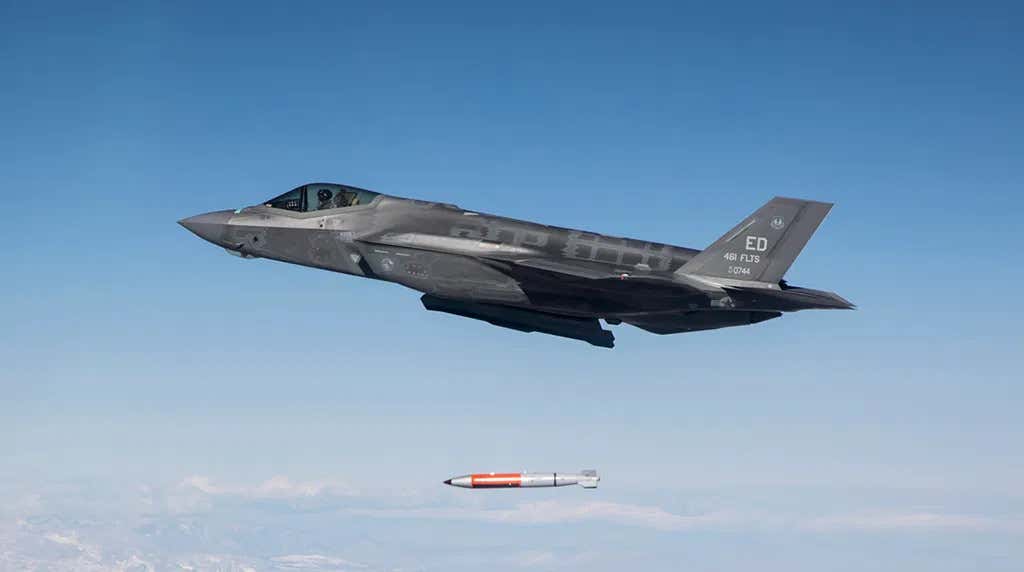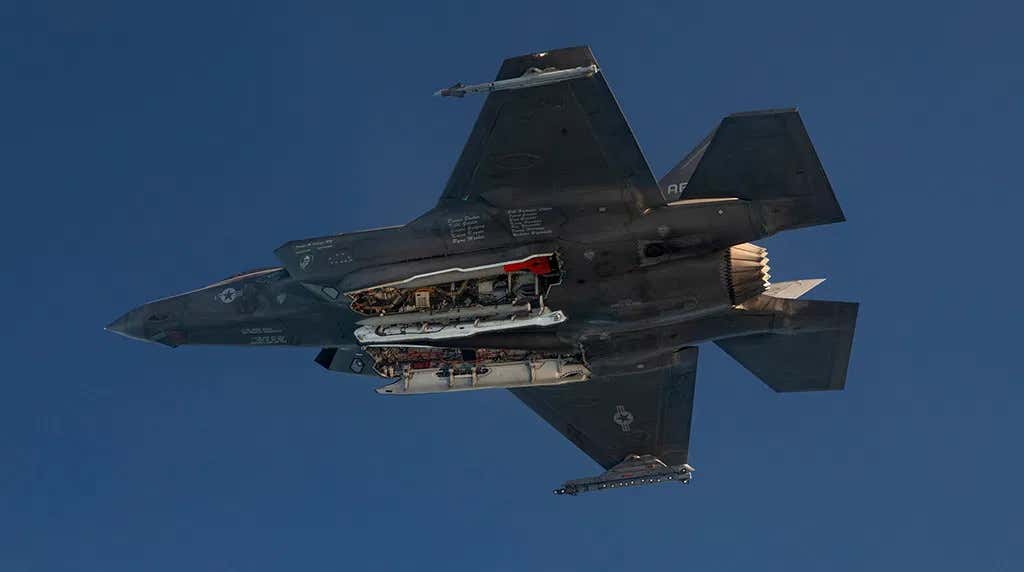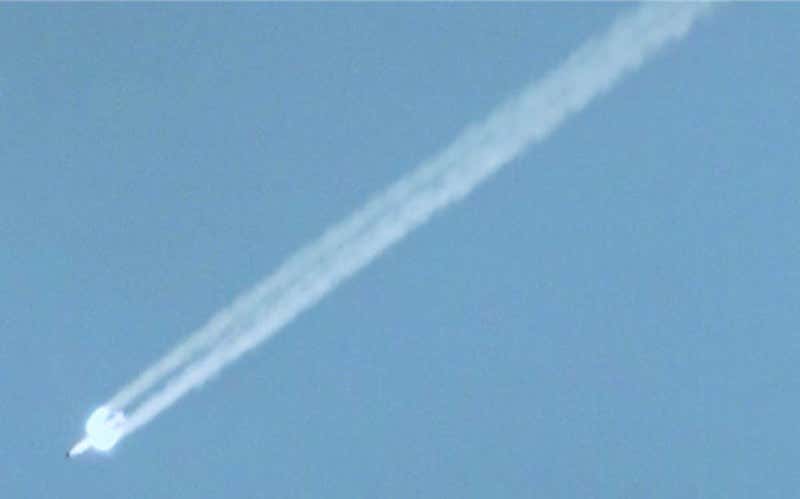Sandia National Laboratories, in cooperation with the Los Alamos National Laboratory and the U.S. Air Force, recently completed a round of flight tests as part of the integration of the new B61-12 nuclear gravity bomb onto the F-35A Joint Strike Fighter. Sandia has also released first-of-its-kind video footage of one of these test sorties, which involved the first-ever release of an inert version of this weapon from an internal bomb bay on a plane flying faster than the speed of sound and that also provides an unprecedented look at the bomb's rocket spin stabilization system.
The press release from Sandia said that the supersonic test had taken place over the Tonopah Test Range on Aug. 25. The range is a secretive site nestled in the northwestern end of the sprawling Nevada Test and Training Range and it has been used for various kinds of nuclear weapons testing, as well as other sensitive research and development and test and evaluation activities, over the years. You can see a rare video tour montage of the range in this previous post of ours.
The F-35A dropped the test B61-12, which included functional non-nuclear components and simulated nuclear components, from an altitude of 10,500 feet. It took approximately 42 seconds for the bomb to hit the designated target on the range.
Check out the video of the test below:
We successfully executed this historic, first-ever F-35A flight test at Tonopah Test Range within the specified delivery criteria,” Brian Adkins, the range manager at the facility, said in a statement.

An F-35A drops an inert B61-12 bomb during an earlier flight test.
“This was the first test to exercise all systems, including mechanical, electrical, communication and release between the B61-12 and the F-35A,” Steven Samuels, a manager with Sandia’s B61-12 Systems Team, added. “The latest test is a critical piece in the F-35A and B61-12 program."
The test was particularly significant since the F-35A is expected to carry the B61-12 internally, unlike other so-called "dual-capable" combat jets able to fly at supersonic speeds, such as the F-15E Strike Eagle, which will also be able to employ this weapon. The Air Force's existing stealthy B-2 Spirit and the future B-21 Raider bombers will also carry these bombs internally, but fly at subsonic speeds.

The red tail of an inert B61-12 is visible inside the bomb bay of this F-35A during an earlier flight test.
The video from the test, seen earlier on in this piece, also gives a very good look at the function of the pair of angled rockets in the bomb's mid-section, which fire after it has been released to give it spin stabilization for greater accuracy. The B61-12 is also the first weapon in this family of nuclear bombs, which you can read about in more detail in this past War Zone feature, to have a precision-guidance system in the form of a tail kit that contains a GPS-assisted inertial navigation system (INS), similar in some general respects to the ones used on conventional Joint Direct Attack Munition (JDAM) bombs.

A screen capture from the video of the F-35A's supersonic release of the B61-12 in August, showing the bomb's rocket spin stabilization system in action.
There have been other flight tests involving inert B61-12s loaded on F-35As since as least 2019. The F-35 Joint Program Office (JPO) released photos of some of those initial flight tests in June, before they pulled them offline.
The goal is for the full flight test series involving the F-35A to also "conclude with full-weapon systems demonstrations designed to increase confidence the bomb will always work when needed and never under any other circumstances." It's not clear when this test program might finally wrap up, but back in 2017, reports had said that the goal was to have the B61-12 integrated onto the F-35A by the end of this year. The Air Force declined to provide an updated timeline to The War Zone in response to a query earlier this year, citing "operational security reasons." Especially given the ongoing COVID-19 pandemic, it seems unlikely now that the Air Force's Joint Strike fighters will be certified to carry this weapon before sometime next year, at the earliest.
In March, Sandia had also announced that it had demonstrated that the B61-12 was fully-compatible with the F-15E Strike Eagle. It says it did the same with regards to the B-2 Spirit stealth bomber in June. It's unclear if the Air Force's nuclear-capable B-52 bombers will ever be certified to carry this weapon. These aircraft presently are not approved to carry any nuclear gravity bombs, owing to their vulnerability to increasingly more capable air defenses, and look set to only carry nuclear-tipped cruise missiles in the immediate future.
Integration on the F-16C/D Viper is still planned, in part to support NATO nuclear sharing commitments, as well. With Germany now set to buy F/A-18E/Fs to replace its Panavia Tornados, which it, as well as Italy, has used in the dual-capable role, adding the B61-12 to the Super Hornet's arsenal is now on the agenda, as well.
The exact schedule for integrating the B61-12 onto any of these aircraft may be somewhat moot, at least in the near term, given that the Air Force does not expect to receive the first production B61-12s until 2022. The National Nuclear Security Administration, which is responsible for overseeing U.S. nuclear weapons production and the sustainment of the country's nuclear stockpile, announced in 2019 that its delivery plans for this bomb, as well as upgraded W88 ALT 370 warheads for the Navy's Trident D5 submarine-launched ballistic missiles, had been significantly delayed after it was discovered that a commercially sourced component did not meet its strict reliably requirements.
Sourcing replacements for those parts, each one of which cost just $5, is expected to cost $850 million. This is all on top of previous delays and cost increases with regards to the B61-12, each one of which is set to cost more than its literal weight in gold.
Sandia, together with Los Alamos and the Air Force, are clearly making good progress in ensuring that whenever the first B61-12s do enter service, the Air Force's F-35As will be able to carry them, if the call to do so ever comes.

 www.thedrive.com
www.thedrive.com
The press release from Sandia said that the supersonic test had taken place over the Tonopah Test Range on Aug. 25. The range is a secretive site nestled in the northwestern end of the sprawling Nevada Test and Training Range and it has been used for various kinds of nuclear weapons testing, as well as other sensitive research and development and test and evaluation activities, over the years. You can see a rare video tour montage of the range in this previous post of ours.
The F-35A dropped the test B61-12, which included functional non-nuclear components and simulated nuclear components, from an altitude of 10,500 feet. It took approximately 42 seconds for the bomb to hit the designated target on the range.
Check out the video of the test below:
We successfully executed this historic, first-ever F-35A flight test at Tonopah Test Range within the specified delivery criteria,” Brian Adkins, the range manager at the facility, said in a statement.

An F-35A drops an inert B61-12 bomb during an earlier flight test.
“This was the first test to exercise all systems, including mechanical, electrical, communication and release between the B61-12 and the F-35A,” Steven Samuels, a manager with Sandia’s B61-12 Systems Team, added. “The latest test is a critical piece in the F-35A and B61-12 program."
The test was particularly significant since the F-35A is expected to carry the B61-12 internally, unlike other so-called "dual-capable" combat jets able to fly at supersonic speeds, such as the F-15E Strike Eagle, which will also be able to employ this weapon. The Air Force's existing stealthy B-2 Spirit and the future B-21 Raider bombers will also carry these bombs internally, but fly at subsonic speeds.

The red tail of an inert B61-12 is visible inside the bomb bay of this F-35A during an earlier flight test.
The video from the test, seen earlier on in this piece, also gives a very good look at the function of the pair of angled rockets in the bomb's mid-section, which fire after it has been released to give it spin stabilization for greater accuracy. The B61-12 is also the first weapon in this family of nuclear bombs, which you can read about in more detail in this past War Zone feature, to have a precision-guidance system in the form of a tail kit that contains a GPS-assisted inertial navigation system (INS), similar in some general respects to the ones used on conventional Joint Direct Attack Munition (JDAM) bombs.

A screen capture from the video of the F-35A's supersonic release of the B61-12 in August, showing the bomb's rocket spin stabilization system in action.
There have been other flight tests involving inert B61-12s loaded on F-35As since as least 2019. The F-35 Joint Program Office (JPO) released photos of some of those initial flight tests in June, before they pulled them offline.
The goal is for the full flight test series involving the F-35A to also "conclude with full-weapon systems demonstrations designed to increase confidence the bomb will always work when needed and never under any other circumstances." It's not clear when this test program might finally wrap up, but back in 2017, reports had said that the goal was to have the B61-12 integrated onto the F-35A by the end of this year. The Air Force declined to provide an updated timeline to The War Zone in response to a query earlier this year, citing "operational security reasons." Especially given the ongoing COVID-19 pandemic, it seems unlikely now that the Air Force's Joint Strike fighters will be certified to carry this weapon before sometime next year, at the earliest.
In March, Sandia had also announced that it had demonstrated that the B61-12 was fully-compatible with the F-15E Strike Eagle. It says it did the same with regards to the B-2 Spirit stealth bomber in June. It's unclear if the Air Force's nuclear-capable B-52 bombers will ever be certified to carry this weapon. These aircraft presently are not approved to carry any nuclear gravity bombs, owing to their vulnerability to increasingly more capable air defenses, and look set to only carry nuclear-tipped cruise missiles in the immediate future.
Integration on the F-16C/D Viper is still planned, in part to support NATO nuclear sharing commitments, as well. With Germany now set to buy F/A-18E/Fs to replace its Panavia Tornados, which it, as well as Italy, has used in the dual-capable role, adding the B61-12 to the Super Hornet's arsenal is now on the agenda, as well.
The exact schedule for integrating the B61-12 onto any of these aircraft may be somewhat moot, at least in the near term, given that the Air Force does not expect to receive the first production B61-12s until 2022. The National Nuclear Security Administration, which is responsible for overseeing U.S. nuclear weapons production and the sustainment of the country's nuclear stockpile, announced in 2019 that its delivery plans for this bomb, as well as upgraded W88 ALT 370 warheads for the Navy's Trident D5 submarine-launched ballistic missiles, had been significantly delayed after it was discovered that a commercially sourced component did not meet its strict reliably requirements.
Sourcing replacements for those parts, each one of which cost just $5, is expected to cost $850 million. This is all on top of previous delays and cost increases with regards to the B61-12, each one of which is set to cost more than its literal weight in gold.
Sandia, together with Los Alamos and the Air Force, are clearly making good progress in ensuring that whenever the first B61-12s do enter service, the Air Force's F-35As will be able to carry them, if the call to do so ever comes.

Watch An F-35 Drop A B61 Nuclear Bomb In This First-Ever Declassified Video
The supersonic drop test puts the F-35A a step closer to being able to employ the new nukes, which are literally worth more than their weight in gold.


